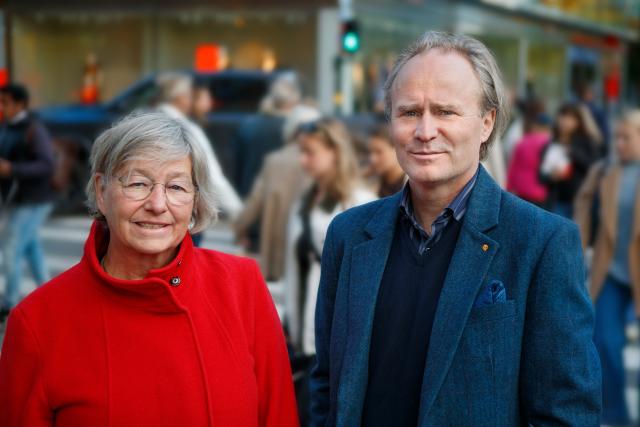

The Anthropocene Laboratory: tasked with finding new pathways toward a sustainable future
The Anthropocene Laboratory is a research program with the overarching aim of creating and disseminating science-based understanding to find new pathways toward a sustainable future. The researchers on the project want to establish robust facts and build hope – that it is still possible to reverse the negative trajectory that the world is currently on.
“We want to create new knowledge and synthesize existing knowledge. This is about large, complex issues around which there is a substantial degree of uncertainty,” says Henrik Österblom, the laboratory’s director and professor of environmental science.
You can safely say that there are multiple, large and challenging issues that all contain a considerable amount of uncertainty. The research community does not even really agree on the concept of the Anthropocene.
In March 2024, there was a vote on a proposal to introduce a new geological epoch starting from 1952 onwards. But despite this, the concept is generally accepted as an expression of the period from the 1950s onwards when human activity has affected the Earth’s ecosystems in profound and diverse ways.
The term the Biosphere is widely used as a description of the thin layer of live around Earth that extends from the outermost part of the Earth’s crust to the outer edges of the atmosphere and contains all the Earth’s ecosystems, including humans.
Creating rings on the water
Of course, no one, neither Österblom nor anyone else, believes that the research program’s four researchers, two postdoctoral fellows and two visiting professors will solve the major challenges the world faces in terms of climate change, biodiversity degradation and the effects on human health, on legislation, democracy and security. Rather, it is about creating rings on the water through small actions that drive change in the research community and the wider world.
“We want to reveal the broad outlines, what’s relevant, what has impact, and what can be system changing. There are extraordinary amounts of data we can go through. We also want to be a bridge between natural sciences, social sciences, humanities, the arts and everything in between,” says Österblom, who mentions the UN Intergovernmental Panel on Climate Change (IPPC) reports as providing extremely good syntheses of available facts on the one hand, but limited implementation on the other.
“There’s a large implementation deficit. We want to try to understand why it is so difficult to implement measures that we know are effective.”
When positions on the program were advertised, applications flooded in from some 70 countries.
“There was a fantastic amount of interest and a wide variety [of applicants]. The job announcements were based on the idea of having two research tracks. One of the successful applicants has expertise in particle physics and anthropology, another in energy systems and equitable resource distribution; one specializes in food systems, one is a chemist and yet another has an environmental and business background – they’re all from outside Sweden.”

No actual lab
The Anthropocene Laboratory, which is funded by Marianne and Marcus Wallenberg Foundation and Marcus and Amalia Wallenberg Memorial Foundation, is located on the Swedish Royal Academy of Sciences campus. And there is no actual laboratory in the true sense of the word. No samples are examined, no liquids are mixed; however, during an initial period of the project, methods and approaches were mixed to find a new scientific approach that is robust for researchers from all disciplines. The aim is to establish an internationally recognized meeting place for collaboration between researchers who want to address key issues for sustainable development.
“Our method is very much about gathering researchers from all over the world from different disciplines. Before our first workshop, most people said: ‘This sounds really exciting, but it can’t be done’. We’re inviting the most interesting researchers in the world. For example, we invited an Israeli epigeneticist who said she didn’t know why she was coming, but she came and later said: ‘I am intrigued’.
Twin research tracks
Work has started on two research tracks entitled ‘Hope in the Anthropocene’ and ‘An Intertwined Biosphere’.
“There are many horror stories around, which are quite exhausting: that nobody can be trusted; that it’s too late to do anything about climate change... And sure, great challenges abound, but at the same time, the potential for humans to collaborate, to innovate and solve problems has never been greater than in the interconnected world we live in today. We want to balance hope and despair with the help of facts produced through a robust scientific method.”
In concrete terms, Österblom says that this involves looking at how legislation is used to change the relationship between humans and the natural world.
“We spend a lot of time looking at how legislation works and how it is used to ensure the rights of nature and Indigenous rights. We look at energy and transport systems and the rapid development of battery-powered vehicles, solar cell use and wind power. We study how nature is protected and restored, and how institutions, politics, business address these issues. We try to look broadly across systems and geographies, at promising developments, and we are interested in understanding the actors driving change. We can observe how individual legal cases are disseminated and establishing precedents, but we are also interested in understanding setbacks that arise.”
“There’s a large implementation deficit. We want to try to understand why it is so difficult to implement measures that we know are effective.”
Collaboration with artists
The aim is that the knowledge the project compiles will result in articles being published in recognized peer-reviewed scientific journals. The research team also wants to work with artists and find ways to reach out to more audiences.
“We want to organize public seminars to bring together various societal actors around specific issues, and work with artists, museums and art galleries. We have already established a collaboration with several artists and the Accelerator art gallery, and we have started working with the Nobel Museum,” explains Österblom.
Scientifically, they collaborate with bodies such as KTH’s Centre of Excellence for Anthropocene History, the Max Plank Institute in Jena, with Stanford University and the slightly closer Stockholm Resilience Centre and the Beijer Institute.
“As I said, we’re a small team and we don’t want to build up a large group; rather, we want to invest in building networks, publish good articles, and be a hub for young researchers who can take forward the scientific method we’ve developed and share it with other institutions,” says Österblom.
Text: Carina Dahlberg
Translation: Nick Chipperfield
Illustration: AI generated
